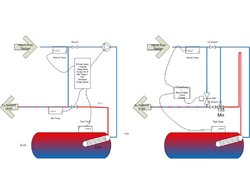I want to limit the output of my heat exchanger to 135F to use for radiant heat and domestic hot water. I was orginally considering a tempering valve but they have some limits (cost for 1 1/4" valve, "cold" input limit 80F, etc.). What I want to do is run the radiant return through the in tank heat exhanger if the tank temp is greated than the return temp, then limit the heated supply temp to 135F by mixing with some of the return flow. This is kind of like modulating the boiler return temp except I want to limit a maximum temperature. I am using 1 1/4 to limit head loss in the piping for the 3 zone and DHW (max flow is 9GPM for the three heating zones). Does someone know of a pump control and controlable circulator that could do this? In the left hand side of the drawing in the circulator based control logic (if tank is colder, no pumping and water will take path of least resistance bypassing the heat exchanger). Pump speed is decreased if the supply temp is greater than 135F allow mixing with the return flow (<120F). On the right is a Taco EBV approach using a tempering valve (if I can find one that will take up to 120F cold water input). Thanks for your help.
HX Output Tempering
- Thread starter Hunderliggur
- Start date
-
Active since 1995, Hearth.com is THE place on the internet for free information and advice about wood stoves, pellet stoves and other energy saving equipment.
We strive to provide opinions, articles, discussions and history related to Hearth Products and in a more general sense, energy issues.
We promote the EFFICIENT, RESPONSIBLE, CLEAN and SAFE use of all fuels, whether renewable or fossil.


